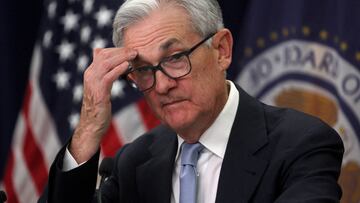How could the job market affect the Fed’s decision on rate hike in June?
The policymakers have talked about cooling the labor market to bring down inflation but May data showed hirings above expectations. How will the Fed react?

Policymakers at the Federal Reserve have been signaling that they would “skip” a rate hike in June when they meet in two weeks. The language the central bankers have been using has been designed to avoid investors thinking that rate hikes would end or even be reversed.
After ten consecutive increases, the overnight bank funding rate has gone from near zero to the range of 5.00% to 5.25% since March 2022. The policy of aggressively raising rates has been designed to bring down inflation by slowing the US economy. However, month after month the data shows that it is still going strong with job openings increasing even as hiring surpassed expectations once again.
Although inflation is still more than double the target of the US central bank and despite the strong economic data, future traders are now betting that the Fed will keep rates at the current level.
The May #JobsReport showed continued growth across industries, adding another 339,000 jobs. 📈 Since President Biden took office, the economy has added 13.1 million jobs. See more highlights: https://t.co/iFGR6uizeK pic.twitter.com/fvEqp3IyXp
— U.S. Department of Labor (@USDOL) June 2, 2023
How could the job market affect the Fed’s decision on rate hikes in June?
The US Labor Department reported on Wednesday that job openings rose by 358,000 to 10.1 million in April. That pushed up the number of jobs available from 1.7 to 1.8 per unemployed worker looking for employment.
Then on Friday data showed that employers added 339,000 jobs across a broad set of industries in May. This was well in excess of what economists had predicted, 190,000, in a Reuters survey. Additionally, April’s number, 253,000, was revised upwards by 93,000.
However, unemployment rose from 3.4 percent to 3.7 percent which was higher than forecast. As well, hourly wage growth slowed and hours worked declined. This led investors and analysts to believe that Fed policymakers will hold off hiking rates again in June while they get a clearer picture of where the economy is going in order to make their “data dependent” decision.
The Fed shifted to a “meeting-by-meeting” approach at the Federal Open Market Committee (FMOC) get-together in May. In theory, policymakers will let incoming data shape their choices on what to do with interest rates. Another important piece of economic data, the Consumer Price Index for May, will be released 13 June, the first of the two days the FMOC will meet to make their decision.
Former Fed Governor Randy Kroszner says unless the US gets an immaculate disinflation, he doesn't see the Fed cutting "anytime soon" https://t.co/vTyXJG4JxP pic.twitter.com/76v0m0L426
— BSurveillance (@bsurveillance) June 2, 2023
Interest rates expected to go up and remain high
Related stories
While the chances for a rate increase in June have dropped to around 25 percent according to the CME FedWatch Tool, there are expectations that the US central bank will raise rates at least one more time, most likely at their July meeting. There is almost no prospect of the Federal Reserve cutting rates this year as they will need to see a consistent reduction of inflation.
Debt traders have pretty much priced out the possibility interest rates coming down before yearend. Former Fed Governor Randy Kroszner told Bloomberg that he sees rates staying above 5 percent for longer than many expect and “for sure” could go up to 6 percent.


